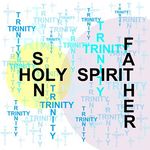
9th Nov 2012. By Rev Dr Steven Kau –
The doctrine of the Trinity is foundational to the Christian faith. It is crucial for properly understanding what God is like, how He relates to us and how we should relate to Him. Granted, the Trinity is a difficult Christian doctrine. All Christians believe the doctrine of the Trinity. If you do not believe this, that is, if you have come to a settled conclusion that the doctrine of the Trinity is not true, you are not a Christian at all. Some may even classify that person as a heretic. Those words may sound harsh but they represent the judgment of the Christian Church across the centuries. Christians in every land unite in proclaiming that our God eternally exists as Father, Son and Holy Spirit. Those who deny that truth, place themselves outside the pale of Christian orthodoxy.
Having said that, I admit that no one fully and completely understand it. It is a mystery and a paradox. Yet, I believe it is true. I can think of at least three reasons for believing in the Trinity:
- The Bible teaches this doctrine.
- Christians everywhere have always believed it.
- No other explanation makes sense.

Someone has said it this way: “If you try to explain the Trinity, you will lose your mind. But if you deny it, you will lose your soul.”
I will attempt to explain in the simplest way possible what I understand the Trinity to be. I pray I will not lose my mind in the process. I appreciate that those who are going to read this explanations are probably not theologians and bible scholars but very ordinary people like you and me. So no heavy stuff like theological jargons, Hebrew and Greek (except where necessary) and all the other stuff that promises to confuse you more than help. This is a lay man’s approach. Needless to say, I cannot give this subject an exhaustive treatment in this short article and answer all the questions and seeming contradiction that’s peculiar to this subject. This is so that you know where I am coming from. So let’s begin.
The Doctrine Defined.
There are many places we might go to find a suitable definition. Any of the great ecumenical creeds would serve us well in this regard. But for want of simplicity, here is my definition:
We believe in one living and true God, who is the Creator of heaven and earth; who is eternal, Almighty, unchangeable, infinitely powerful, wise, just and holy.
We believe that the one God eternally exists in three Persons: the Father, the Son and the Holy Spirit; and that these three are one God, co-equal and co-eternal, having precisely the same nature and attributes and worthy of precisely the same worship, confidence and obedience. (Matthew 3:16-17; Matthew 28:19-20; Mark 12:29; John 1:14; Acts 5:3-4; 2 Corinthians 13:14)
While I am sure that this statement is biblically accurate, I also understand that it can seem very intimidating. Let’s break it down into six smaller statements:
- Exist in three person
- Equal and Eternal.
- Worthy of Equal Praise and Worship
- Distinct, yet acting in unity.
- Constituting the one true God of the Bible.
- One God and One Only.
As you might imagine the early church struggle mightily over this doctrine. They eventually reduced their belief in the Trinity to two short statements. They concluded that God is:
- One in Essence
- Three in Person
When we say these things, we mean that the Father is God, the Son is God and the Holy Spirit is God but they are not three Gods but only one God. The Father is not the Son, the Son is not the Spirit and the Spirit is not the Father but each is God individually and yet, they are together the one true God of the Bible.
Have you ever seen the word “Godhead?” Theologians sometimes use that term when they want to refer to God the Father, God the Son and God the Holy Spirit as three divine Persons in one God.
At this point, I think we should acknowledge the chief objection to the doctrine of the Trinity, which is that it is absurd. Sometimes the Jehovah’s Witnesses (who pointedly deny the Trinity) ridicule it with this little equation: 1+1+1=3. In their minds, Christians worship three Gods, not one. You don’t have to be a mathematics genius to know that indeed one God plus one God plus one God indeed equals three Gods. The answer to that is quite simple. The doctrine of the Trinity is not absurd if that’s what the Bible teaches! Furthermore, there is more than one way to play with equations. You could also say it this way: 1x1x1=1.
The Doctrine Explained
What exactly do we mean when we speak of the Trinity? Let’s start with the negative and work toward the positive.
A. What we don’t mean.
First of all, Christians don’t believe in three Gods. That’s a heresy called Tritheism. Second, we don’t believe that the Father, Son and the Holy Spirit are three “forms” of God – like steam, water and ice. That’s the heresy called Modalism. Third, we don’t believe that the Father, Son and Holy Spirit are “parts” or “pieces” of God. That would imply that Jesus is 1/3rd God, the Father is 1/3rd God and the Holy Spirit is 1/3rd God.
B. Where do we find this doctrine in the Bible?
I would answer that the Trinity is taught in both the Old and the New Testaments. It is taught by implication in the Old and by direct statement in the New.
For instance, the Bible contains numerous clear statements regarding the unity of God: Deuteronomy 6:4 tells us that “the Lord is one.” 1 Corinthians 8:4 adds that “there is no God but one.” 1 Timothy 2:5 explicitly says “there is one God.” All Christians heartily affirms this truth.
However, the Bible also contains clear statements regarding diversity within that unity. For instance, in the very first verse of the Bible, we are told that “In the beginning God….” The Hebrew word for God is ‘Elohim’ which is actually a plural form of the word ‘el.’ It’s a word that in other contexts is sometimes translated as “gods,” referring to heathen deities. Later in the same chapter, we have one of the most striking statements of diversity-in-unity.
Then God said, “Let us make man in our image, in our likeness and let them rule over the fish of the sea and the birds of the air, over the livestock, over all the earth and over all the creatures that move along the ground.” So God created man in his own image, in the image of God he created him; male and female he created them.” (Genesis 1:26-27)
Notice the shift in pronouns. “Let us…….in our image…..So God created man in his own image……He created him.” From us and our to he. Why the shift? Commentators speak of a literacy form called the plural of majesty or the “editorial we.” This much is certainly true. If Genesis 1 does not explicitly teach diversity-in-unity within the Godhead, it certainly leaves room for it to be developed later in the Bible.
Isaiah 48:16 seems to explicitly refer to all three Persons of the Trinity (with my additions in parentheses):
“And now the Sovereign LORD (the Father) has sent me (the Son) with his Spirit (the Holy Spirit.” I’m not suggesting that Isaiah fully understood the Trinity or that the Jewish readers would have understood what it meant but I do think that in the light of the New Testament, we can say that this seem to be a clear statement of the Trinity in the Old Testament.
Consider further this line of evidence. All three Persons are called God in different places in the Bible.
- Father ………………………..Galatians 1:1
- Son ………………………. John 20:28
- Spirit ………………………. Acts 5: 3-4
How could the Son and the Spirit be called God unless they somehow share in God’s essence? But if they share in God’s essence, they are God alongside the Father.
Finally, all three Persons are associated together on equal basis in numerous passages:
Jesus’ Baptism – Matthew 3:13-17 (Voice of the father, Son baptized, Spirit descending like a dove.)
Salvation – 1 Peter 1:2 (Chosen by the Father, sanctified by the Spirit, sprinkled with the blood of Jesus)
Sanctification – 2 Corinthians 13:14 (Grace of the Lord Jesus, love of God, fellowship of the Holy Spirit)
Christian baptism – Matthew 28:19 (Baptized in one name, yet three Persons – Father, Son and holy Spirit.)
Prayer – Ephesians 3:14-21 (Strengthened by his Spirit, know the love of Christ, filled with the fullness of God.)
Christian growth – 2 Thessalonians 2;13 (Chosen by God, loved by the Lord, sanctified by the Spirit.)
The list of passages might be extended. It simply show how easily the writers of scripture passed from one Person of the Trinity to another, doing so in a way that assumes their equality of nature, while preserving their distinct personhood. If the doctrine of the Trinity is not true, it would seem to be blasphemy to speak so freely of the Father, the Son and the Holy Spirit in one and the same breath.
The Doctrine Examined
In this section of the article I want to examine some of the common questions about the Trinity.
a. Where in the Bible do you find the word Trinity?
It is true, the word Trinity is not found in the Bible. This has led some to the conclusion that belief in the Trinity is not biblical. However, the word “theology” is also not found in the Bible either. Theology means the study of God. No one doubts that the Bible teaches theology because the precise term is not used. The same can be said of the word Rapture. In the same manner, the Trinity is taught in Scripture without the use of the term. It is not the specific word Trinity that is the issue. The real question is, “Does the teaching about the Trinity conform to what the Bible says about God’s nature. That is the real issue.
b. The Trinity is a pagan idea adopted by Christians.
It is often charged that the idea of the Trinity is a pagan idea that the church adopted. There are a number of points that need to be made to refute this accusation.
Those who attempt to compare the Trinity with teachings in other religions either do not understand the doctrine of the Trinity or what the other religions teach concerning the nature of God. Many say that the doctrine of the Trinity was influenced by religions of ancient Babylon, Egypt and Assyria have been mentioned. Eastern religions such as Buddhism and Hinduism have also been referred to from time to time. Yet, these religions are radically different from one another in their beliefs. The fact that there were a number of ancient religions that worshipped three gods is irrelevant. These gods were separate gods, not one god as in the Trinity. Furthermore, the three gods worshipped in these cultures were usually the chief gods. There were many other gods these people worshipped apart from the chief ones. The similarity of the number three proves nothing with respect to derivation or influence.
Further, the supposed derivation of the Trinity from pagan concepts come either too early or too late in history or are too far away geographically. For example, comparison to the worship of three gods in Egypt and Babylonia will not work. These gods were worshipped two thousand years before Christ came. India, where Buddhism and Hinduism arose, was too far removed geographically. There are no credible sources where the doctrine could have come from. Finally, there is a logical fallacy involved. The fact that some ancient religion may have some similar belief to the Trinity does not mean they are the same or that the Trinity was influenced by them. Similarity does not mean the same.
c. Is there another word we could use?
Yes, there is. Theologians sometimes speak of the Tri-unity of God. That’s a good word, even though it sounds odd to our ears, because it combines the two ideas of unity and diversity in one word. There is a third word you should know. Sometimes we speak of the “Triune” God. That’s also another word that means the same thing as Trinity.
d. How can we illustrate the Trinity?
A number of illustrations have been suggested. They are all useful as long as you remember they are only illustrations. For water can exist as solid, liquid or steam. That’s okay but usually water only exists in one state at a time. I saw an experiment once, where water was placed in a tested tube and subject to a certain freezing temperature. When it was removed, the top of the test tube was solid with ice, the center of the tube was gaseous and the lower portion was liquid. Three different state of water in one test tube.
There are others we could mention. An egg is made up of a shell, the eg-white and egg-yolk. All three are needed for an egg to be complete. One of the more interesting illustration notes the different roles a person can play. I am a father, a son and a husband at one and the same time. Yet, I am only one person. Perhaps a more biblical approach is to consider that a husband and wife are two persons, yet in God’s eyes they are “one flesh.’ Add children and then you have the family as a miniature (very imperfect) version of the Trinity.
Tony Evans commented that the pretzel is a good illustration because it consists of one piece of dough with three holes. Take away any one of the holes and the pretzel isn’t really a pretzel anymore.
My personal favorite illustration comes from noted scientist Dr. Henry Morris. He notes that the entire universe is Trinitarian by design. The universe consists of three things: matter, space and time. Take away any of those three and the universe would cease to exist. But each one of those is itself a trinity.
Matter = Mass + Energy + Motion.
Space = Length + Height + Breath.
Time = Past + Present+ Future.
Thus the whole universe witnesses to the character of the God who made it. (Ps 19:1) It is important to remember that all illustrations fail eventually. They don’t “prove” the Trinity; they simply help us understand the concept.
e. The Trinity doctrine is a mystery that is impossible to understand.
When the Trinity is referred to as a “mystery,” it is a mystery in the biblical sense of the term – that is a scared secret. A mystery in the Bible does not mean something that cannot be understood. A mystery is something that was previously unknown but now revealed. Paul wrote to the Colossians:
“To them God has chosen to make known among the Gentiles the glorious riches of this mystery, which is Christ in you the hope of glory.” (Colossians 1:27)
This truth about the Gentiles being part of the church, the body of Christ, was something that had not been revealed in the Old Testament. The “mystery” was unveiled during the New Testament era.
The Doctrine Applied
I am sure that many Christians think this doctrine has no practical value. That is, even if it’s true, it doesn’t and shouldn’t matter to them. However, that simply isn’t true. Let me suggest five important ramification of this truth.
A. The Trinity helps us answer the question: “What was God doing before he created the universe?”
This is a question little children like to stump their parents with. But skeptics like to ask it as well. You may remember Augustine’s answer: “He was preparing Hell for people who ask questions like that!”
But the Trinity teaches us that before the foundation of the world, God was having fellowship within His own being. That’s why the Bible tells us that the Father loves the Son. (John 17:24) In some sense, we can never understand that God the Father, God the Son and God the Holy Spirit have forever communicated and loved each other. Francis Schaeffer emphasized this point in his books. This, he says, is where the human desire for intimacy and communication comes from. We were made to communicate. That design is part of the image of God within each of us. It also teaches that God is never “lonely.” He didn’t create us because He “needed” us. God could have existed forever without us. That He made is at all is a statement of His great love and the wisdom of His plan.
B. The Trinity sets the limits on human speculation about the nature of God.
There is so much we would like to know about God but our finite minds cannot comprehend it. We are not free to create God in our image. The Trinity set the limits for human speculation. God is more than the Trinity but He is not less that that.
C. The Trinity teaches us that God is beyond all human comprehension.
After all, if we could explain God, he wouldn’t be God. I have no doubt that God is much more than “one in essence, three in person,” but since I can’t understand those simple phrases, I don’t worry at all about what else might be true about God. If you feel baffled by the Trinity, join the crowd. The greatest minds of history have stood in amazement before a God so great that He cannot be contained by our puny explanations.
D. The Trinity exalts the Son and Spirit.
We all know that God the Father is to be worshiped. But what about Jesus? If He is God, should we not also worship Him? The answer of course is yes. But the truth leads us back to the Trinity. He is not merely the Son of God but also God the Son. The same thing may be said about the Holy Spirit. He is not just a “force” but a Divine Person. Not an “influence” or some vague power but the third Person of the Trinity.
Let me draw one important inference. Since all three Persons of the Trinity are equally God, we may pray to any member of the Trinity. That, by the way, is the number one question I have been asked often about the Holy Spirit and Jesus. Many Christians simply do not feel comfortable praying to the Holy Spirit, even though we often sing songs that are essentially prayers to the Spirit, such as “Spirit of God,” “Come Holy Spirit,” “Spirit of the Living God, fall afresh on me.” Surely, if we may sing to the Spirit, we may also pray to Him. If He is God, our prayers may be directed to Him.
I do agree that Christian prayers will customarily be made to the Father (e.g. The Lord’s Prayer). But let us not quibble or imagine that the Father is slighted if we direct our prayers to the Son or to the Spirit, according to the need of the moment. There is no jealousy among the members of the Trinity nor could there ever be.
E. Doctrine that Unites and Divides.
The doctrine of the Trinity has been called the most puzzling doctrine in the Christian faith and the central truth of the Christian faith. Which is it, inscrutable puzzle or central truth? The answer is both are true. This doctrine unites all true Christians and separates us from those who are not Christian.
Here is an important closing thought. Does a person have to “understand” the Trinity to be saved? What if they believe in God the Father and Jesus as His Son but can’t really grasp the whole “One God in three persons” thing?
I think the answer goes like this. You don’t have to fully understand the Trinity in order to be saved. But if a person having studied the issue, came to the conclusion that the Trinity could not possibly be true, they would be in a position of a Muslim who says, “God can’t have a son.” Such a person might admire Jesus but would never look to Him for salvation. If Jesus is not God’s Son, if He’s only a prophet or a holy man but not the Son of God, then He’s not able to save anyone.
I come now to the end of my article. In so doing, I end where I began. The Trinity is a doctrine that all Christians believe but no one really understands completely. That much should be clear from this article. Now we understand those words I quoted earlier: “If you try to explain the Trinity, you will lose your mind. But if you deny it, you will lose your soul.”
Someone asked Daniel Webster, who happened to be a fervent Christian, “How can a man of your intellect believe in the Trinity?” “I do not pretend fully to understand the arithmetic of heaven now,” he replied. That’s a good phrase – the arithmetic of heaven. The Trinity should cause us to bow in humble adoration before a God who is greater than our minds could ever comprehend.
Rev. Dr. Steven Kau is the pastor of Faith Covenant Church ( FCC ). The church address is at 1-1 Jalan Putra Mahkota 7/5B, 47650 Putra Heights, Subang Jaya, Selangor. Sunday service in English starts at 10 am. His email contact is – kausteven@gmail.com
Disclaimer :
The views or opinions expressed by the writer/columnist is solely their own and do not necessarily represent the views or opinions of Christianity Malaysia.com
###








Have you ever wonder how God the creator of the whole universe + galaxies would introduce himself to mankind ? Jesus the Son of God .
And how he make himself real and alive to those that accept His Son ?
The Holy Spirit .
Remember H 2 0 is the scientific substance for Water , Ice and Steam .
They are the same but yet they come in different form .
Hello RP, yes, good analogy for how God the Trinity comes in God the Father, Jesus Christ the son, and the Holy Spirit.
On a side note, when I read this article, I feel that the action of placing the Holy Spirit in us is a very loving act. How so?
God love us so much that He even chose to live in us so that wherever we are, He is there with us all the time.
So, I used to laugh when I asked for “personal space” from God, because in our relationship as Christians with Him, “distance” with God is non-existent. He is always in reach. And He is always there.
Thank you again for your feedback. God Bless.